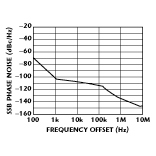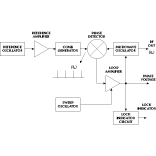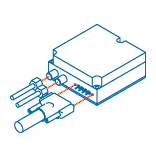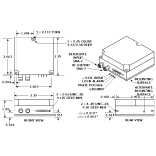A High Stability Phase-locked Source for QAM Radio Applications
Microwave dB
Newbury Park, CA
Consumers have pressured service providers who, in turn, have pressured equipment manufacturers to design wireless communications systems that are more reliable while simultaneously demanding significantly higher data rates. This new generation of radios provides high performance, long life and zero maintenance. Although it is costly for service providers to replace a phase-locked oscillator, the service outage associated with an oscillator failure can be disastrous because of end-user dissatisfaction, which ultimately results in subscriber churn.
A new 9 to 13 GHz high stability, low noise phase-locked source has been designed specifically to address the 155 Mbps data rate requirements of these systems. The PureSource® line of phase-locked sources offers excellent frequency stability with the ultra-low noise performance necessary for today’s high speed digital radios and other low noise applications. In addition, the oscillators feature small size and high reliability.
System Performance Issues
First and foremost, high data rate quadrature amplitude modulation (QAM) radios require a low bit error rate (BER), which translates to low phase noise in the oscillator. The PureSource phase-locked oscillators provide industry-leading phase noise, as shown in Figure 1 .
 Aging is another critical parameter for the oscillator that can affect system performance and maintenance. In addition, low oscillator drift results in optimum data rates and BER. The new oscillators drift less than 2 ppm over 10 years, thus providing an ultra-long service life with no required maintenance or adjustments. Traditional mechanical tuning elements are not present in the design. This fact and careful component selection, in addition to low power (thermal) dissipation, have resulted in a greater than 60-year mean time to failure (MTTF) for the PureSource line of oscillators.
Aging is another critical parameter for the oscillator that can affect system performance and maintenance. In addition, low oscillator drift results in optimum data rates and BER. The new oscillators drift less than 2 ppm over 10 years, thus providing an ultra-long service life with no required maintenance or adjustments. Traditional mechanical tuning elements are not present in the design. This fact and careful component selection, in addition to low power (thermal) dissipation, have resulted in a greater than 60-year mean time to failure (MTTF) for the PureSource line of oscillators.
Microphonic conditions in high performance radios cause increased BER or worst-case, service link outages due to the modems losing lock. In addition, phase hits (or phase pop) in high performance radios can cause an increase in BER, and momentary outages (lost data) occur for the duration of the phase hit due to modems losing lock. PureSource oscillators are designed to minimize environmentally induced (from vibration) errors and performance degradation. Careful selection of semiconductors and materials used in the oscillators minimizes the coefficient of thermal expansion mismatch, additionally optimizes the loop bandwidth and other parameters, and minimizes the effects of vibration and performance degradation.
Harmonics and spurious signals cause mixing products that often generate interfering emissions, resulting in a reduction in dynamic range and limited link performance. To counter these emissions, system designers often are forced to add costly system filtering. The PureSource oscillators provide excellent spurious and harmonic performance through a rigorous selection of circuit architecture and components and the use of internal filtering and linear components.
Finally, power supply ripple can increase phase noise by modulating the oscillator frequency, thus reducing data rates and increasing BER. The new oscillators feature ripple and noise rejection, minimizing these effects. In addition, thermal management of radios often is costly and problematic at remote sites. Designed to require less power, the oscillators ease thermal management issues and allow a smaller and less costly power supply to be used. The PureSource oscillators have the lowest power consumption of any comparable product made for high volume applications.
 Oscillator Specifications
Oscillator Specifications
The PureSource phase-locked oscillators operate from 9 to 13 GHz and are available in both internal and external reference configurations. Figure 2 shows a PureSource oscillator’s functional block diagram. Power output is +16 dBm (min) with a ±1 dB variation over the oscillator’s -40° to +80°C operating temperature range. Harmonic and spurious levels are less than -40 and -80 dBc, respectively.
The oscillator’s phase noise within the loop bandwidth is a function of the noise of the external reference signal degraded by 20logN + 3 dB, where N is the multiplication factor applied to the reference to produce the output frequency. Outside the loop bandwidth at 1 MHz from the carrier the phase noise is -133 dBc/Hz at 13 GHz. The required external reference power input is -3 to +3 dBm. The reference and RF output port SWRs are 1.5 (max) referenced to 50 W. A standard phase lock voltage of 0 to +5 V DC may, in turn, be specified by the user to be anywhere in the 0 to +10 V range, and a TTL phase lock alarm is supplied (1 = locked, 0 = unlocked).
 The PureSource oscillators are powered by +12 ±1 V DC and typically draw 200 mA (250 mA, max) (heater off). RF and reference connectors are SMA-F, and the DC and alarm connections are pins. A multipin female connector and cable assembly may be used to connect to the DC/alarm pins for easy installation and removal, as shown in Figure 3 . Figure 4 shows the oscillator’s mechanical outline.
The PureSource oscillators are powered by +12 ±1 V DC and typically draw 200 mA (250 mA, max) (heater off). RF and reference connectors are SMA-F, and the DC and alarm connections are pins. A multipin female connector and cable assembly may be used to connect to the DC/alarm pins for easy installation and removal, as shown in Figure 3 . Figure 4 shows the oscillator’s mechanical outline.
 To minimize manufacturing cost, the oscillators have been designed to use automated assembly and test techniques. State-of-the-art automated component placement equipment assures high production rates and consistent performance. The use of standard surface-mount components and processes reduces the likelihood of component shortages. As a result, the PureSource oscillators offer high performance and reliability at a reasonable cost and are among the first commercially available oscillators for use in QAM radio applications. The 10-year service life, 60-year MTTF, superior aging, low power consumption, and plug-and-play cabling options to ease installation and integration make these oscillators ideal for high data rate radio use.
To minimize manufacturing cost, the oscillators have been designed to use automated assembly and test techniques. State-of-the-art automated component placement equipment assures high production rates and consistent performance. The use of standard surface-mount components and processes reduces the likelihood of component shortages. As a result, the PureSource oscillators offer high performance and reliability at a reasonable cost and are among the first commercially available oscillators for use in QAM radio applications. The 10-year service life, 60-year MTTF, superior aging, low power consumption, and plug-and-play cabling options to ease installation and integration make these oscillators ideal for high data rate radio use.
Microwave dB
Newbury Park, CA
(805) 499-0410
